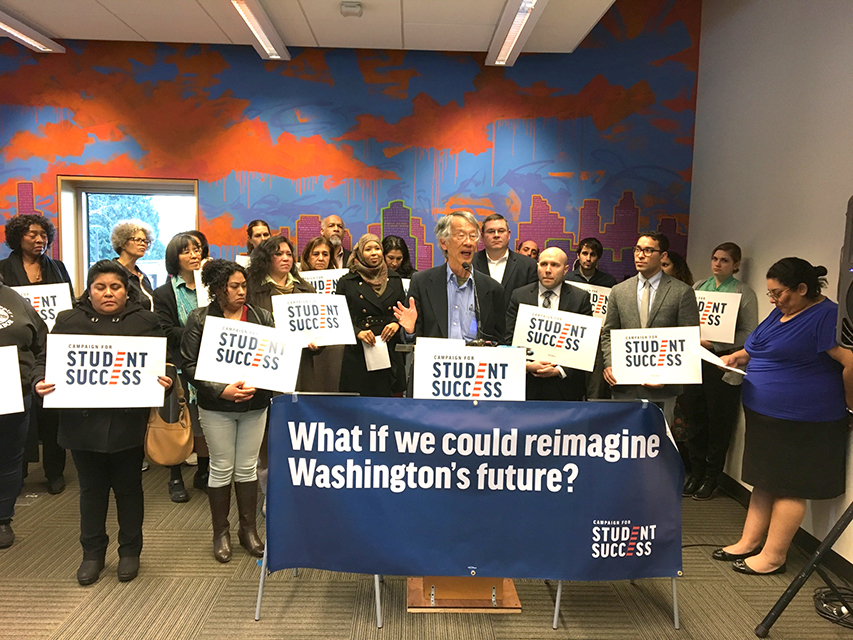By Arlene Kiyomi Dennistoun
Northwest Asian Weekly

Courtesy of the Campaign for Student Success
On March 27, Washington House Democrats unveiled a $44.6 billion plan which would include a new funding formula to fully fund education in Washington as mandated by the state supreme court in the 2012 McCleary case.

Tony Lee
McCleary was the “catalyst” for the “Campaign for Student Success.” Tony Lee, co-founder of the Asian Pacific Islander Coalition (APIC), gives the “Campaign for Student Success” four out of five stars for its overall effectiveness.
Suddenly, the conversation about funding basic education has shifted, and people are now talking about a student-centered funding formula, driving resources to kids who need it the most, and reducing opportunity and achievement gaps. “To shift the conversation is a huge victory, and I think the campaign is hugely responsible for that.”
Officially launched this January to address the fundamental inequities in the education system, the campaign’s message is clear — student funding is unfair today. According to the campaign, wealthy school districts get more money from the state than the schools with a lot of low-income, immigrant, refugee students, and students of color.

Daniel Zavala
Diverse members of the campaign are fighting for sustainable funding, quality education, and fair and equal opportunity for K-12 students, regardless of their background. The campaign is bringing a unified message from its members, parents, and the public to Olympia. “Ultimately, we want to elevate the voice of Washingtonians to the legislature because at the end of the day, that’s where the decisions are made,” said Daniel Zavala, Director of Policy and Government Relations at League of Education Voters (LEV).
The LEV is one of the founding members of the campaign, along with Stand for Children Washington, the Equity for Education Coalition, APIC, and the Statewide Poverty Action Network. The campaign continues to attract members, and at last, count included 31 organizations.
McCleary gives the legislature until 2018 to fully fund basic education. The campaign looked at McCleary as an opportunity to re-engage the public in conversation about education funding. Washington has historically underserved communities in most need. It’s a conversation that must include input, feedback, collaboration, and partnership from these communities, said Zavala. If people are not a part of the conversation, their needs won’t be met. “We must increase the achievement of the children who get left behind,” said Lee.
The Washington Roundtable was initially a campaign member because they shared common goals with the campaign. Thirty-one percent of Washington’s graduates go on to get a post-secondary degree or credential, and the Washington Roundtable’s goal is to raise that to 70 percent. The roundtable posted information on its website that 740,000 jobs will open up in the next five years requiring postsecondary certifications or degrees, and employers want to hire Washington students. The campaign and the roundtable believe that improving low-performing schools to reduce education gaps is critical to the state’s economic future. Although no longer an active member of the campaign, the roundtable continues to share the same vision for Washington students.
The campaign began with an unusually broad bipartisan coalition, said Lee. “We have groups from one end of the political spectrum to the other.” Communities of color, low-income advocates, education reform groups, and initially, the business sector, united with a central goal that “every student in the state should have equal opportunity to achieve and become productive members of society.”
The campaign points to three reasons why the state’s funding system is unfair. First, the staff- ratio mix allows schools with more experienced teachers who gravitate towards higher income school districts to receive more state funding than the schools with inexperienced teachers, who typically start off at low-income schools.
Second, the campaign believes heavy reliance on local property levies is unfair, along with the PTA fundraising advantage that wealthier schools have for enhancements, such as tutors, music classes, and counselors. Lee looked at the Mercer Island PTA that raised a million dollars in one year, while the Rainier School District PTA struggled to raise $5,000. This inequity in funding and resources is one of the reasons why our schools have one of the worst achievement gaps in the country, said Lee.
Third, the model minority myth that Asians do well in school has hurt all students. Data shows that Asian Pacific Americans don’t do as well as people might think, said Lee. Asian Pacific Islanders, Southeast Asians, immigrants, and refugees have one of the worst graduation rates in the state.
The campaign initially commended Senate Bill 5607, the Education Equality Act, as a step in the right direction to bring fairness to Washington’s education system. Upon further review, Lee said they were dismayed to find no additional funding added to K-12 education. If you don’t provide more funding, said Lee, and if you redefine poverty, what ends up happening is a dramatic cut to special education, low income, and highly capable programs. Still, the campaign embraced the student-based funding concept in the bill.
As the legislature nears the semi-final stages of completing its budget for 2017-2019, the campaign continues to fight for its two primary goals — the government must increase overall K-12 funding. And any additional funding the legislature comes up with must distribute education dollars differently. The state must do away with the old staff-ratio mix and drive talent (teachers and paraeducators) and resources to the kids who need it the most.
Arlene can be reached at info@nwasianweekly.com.



